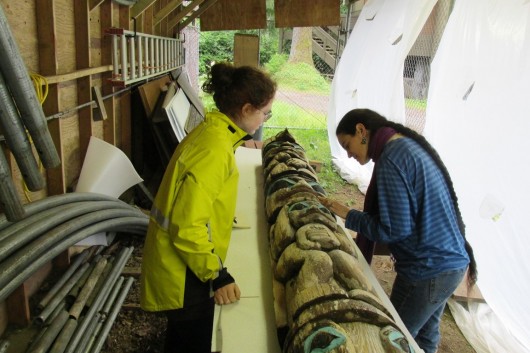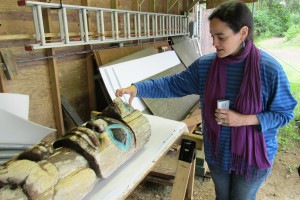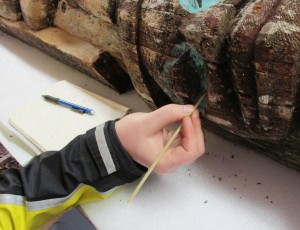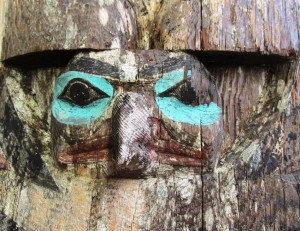
Ketchikan’s Totem Heritage Center has a new pole, relatively speaking. It’s actually 30 years old, but the pole is a new addition to the center’s collection of historic Alaska Native artifacts. Alaska State Museum conservators from Juneau traveled to Ketchikan to help clean and preserve the pole, and to find out what kind of stories might be hidden in the wood.
Ellen Carlee has a tiny lump of metal twisted up in a piece of paper. She’s been trying to find someone who knows what it is.
She shows it to John Radzilowski, a summer guide at the center, who also happens to be a history professor at Ketchikan’s University of Alaska Southeast campus. He doesn’t know either, so she puts it away for the moment.
The Boxley pole where that bit of metal was found is a 30-year-old totem pole, donated to the center by master carver David Boxley.

Carlee is based in Juneau and says she got a call last summer from two Heritage Center employees.
“They said, ‘Hey, we’re under a house in Metlakatla looking at this totem pole, it’s covered with lichen, we think it has an infestation problem. David Boxley wants to donate it to the museum. What do you think we should do?’” she says. “I’m like, ‘Well, I’m in Fred Meyer right now, but here’s what I think.’”
A year later, Carlee and two graduate-level conservation interns have flown to Ketchikan to clean the pole and prepare it for display. She says the artist didn’t really want the pole restored, just preserved.
The cleaning process is meticulous. They had to remove the lichen without damaging the paint. As they gently nudged the vegetation away, that’s when they found the imbedded lumps of metal.
“It looked like it may be some sort of pellet,” she says. “Now that we cleaned it, we’ve seen this in a couple of spots. This pole stood outside the Boxley family home for decades, so probably I should send a picture of this to somebody from Metlakatla and say, what is this? What was it doing in the pole? Because that’s part of the story.”
As Carlee continued talking, intern AnnMarie Guerin carefully wielded a bamboo skewer, scraping remaining bits of lichen tendrils from the pole’s many cracks.

“So, I’ll just test it and see if maybe it’s falling off on its own, and if it is, then I keep going, but if it’s stubborn, I just kind of let it be,” Guerin explained. “I would definitely call it meditative. That was one of the reasons I wanted to get into conservation. I knew there was a lot of meticulous and long-term work, and I know I liked doing that kind of thing. So, I could spend hours doing this. It’s great!”
Leaving the Totem Heritage Center, senior curator of programs Anita Maxwell walks up to say that Radzilowski had found out what the metal pellets are.
“It is from a pellet gun,” Maxwell says. “There’s a specific kind of hollow-core lead pellet, and he even has the website to buy some more. Google is amazing.”
The next step was to find out how it got there. A call to the artist revealed BB guns as the culprit.
“Oh, I’m pretty sure that’s where that came from,” Boxley says, laughing. “There’s lots of little neighbor kids without a whole lot of supervision.”

Boxley says he carved the pole in 1982 to coincide with a potlatch he organized in honor of his grandparents, who raised him. He says it wasn’t the first pole he ever carved, but it was the first large one, for the first potlatch in that community.
“The actual putting on of the potlatch, I didn’t have a lot of help because our people had not had one up ’til then, and I’d never even seen one, been at one. It was all research,” he says. “A few people in my family and a few people from the other clans helped put it together. It was something I had to do.”
While a replacement pole, carved by Boxley and his son, has gone up in the original pole’s place. Boxley says the original is an important part of Tsimshian Native culture and history in Metlakatla.
“It was kind of the symbol of the revitalization of potlatching in Metlakatla,” he says. “It was the first one: first potlatch, first ceremony, first pole-raising.”
Much of the Native culture had been left behind, he says, when the first residents followed missionary Father William Duncan from British Columbia in 1891.
“The education process has been slow, but it’s come a long way,” Boxley says. “I’m pretty proud of my people for everything they’ve done. All the other clans, all the artists who are doing their best.”
With the pole that Boxley donated, the history and significance of an event that began the Tsimshian renaissance will be preserved for generations to come.
